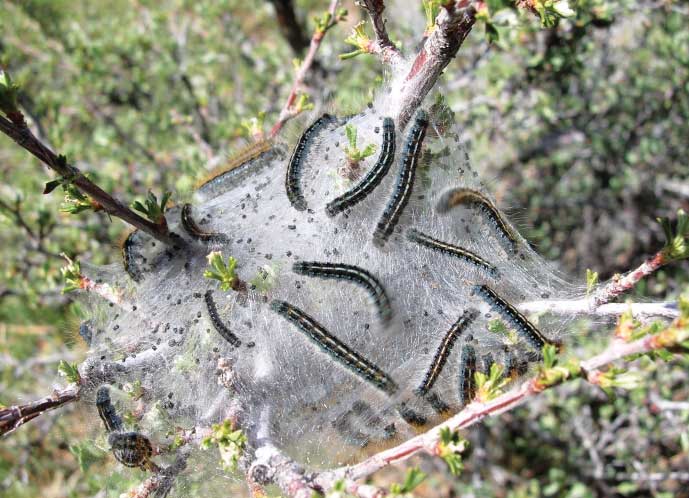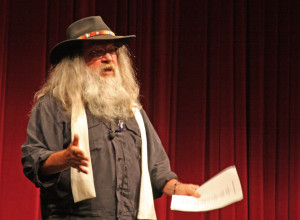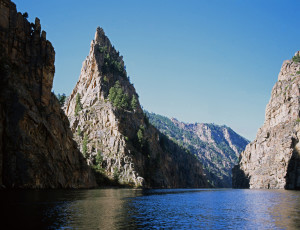by Mike Rosso
Colorado’s diverse forests are renowned for their beauty, their sheer vastness and endless recreational opportunities. But Colorado’s forests are currently experiencing a nearly epidemic level of insect damage. From the Tiger moth to the Douglas fir beetle, few species of trees are immune to the ravaging of these insects, which will change the face of Colorado’s forests for years to come.

The current conditions of forests in Colorado are conducive to insect activity, according to Tom Eager, entomologist with the U.S. Forest Service in Gunnison. He explains several causes for the current high levels. First is the older age class of many of the forest stands in the state.
“At the lower elevations, these trees originated during the latter stages of the settlement period. Forests supplied the majority of the raw materials that were used during the mining and railroading era of a century ago. As economic conditions changed, forest resources were replaced by other materials, thus leaving the forest to regenerate and grow relatively unimpacted by human activities. These forest stands are now reaching the latter stages of their life cycle and have increasingly become susceptible to insect attack,” he explains.
The exclusion of fire, legislative direction and public sentiment has reduced the levels of management ,which has resulted in large stands of older, denser groups of trees. In the higher elevations, forest stands were less impacted by human activity but are currently reaching the latter stages of their life span. As the forests age and reach the latter stages of their life cycle, they become more susceptible to insect attack. Warmer and drier weather patterns over the past decade have created more stress in trees, leading to conditions favorable to insects such as the bark beetle.
“In addition to the long-term cycling of weather conditions, some observers have cited the impact of climate change on forested lands. While warmer, drier weather conditions have been recorded recently, it is impossible to separate out the ‘normal’ climatic patterns from the impacts of climate change,” says Eager. He also notes that the insects that are greatly impacting forests are “responsive to forest condition, and impact older, denser stands of trees. It is the combination of weather patterns, stand conditions, and insect populations that have created the current situation.”
The culprits
After the extreme drought of 2002, a large outbreak of the Piñon ips beetle led to the destruction of a large number of piñon trees in Southern Colorado and Northern New Mexico. The piñon ips usually acts as a scavenger and opportunist in the forest, taking advantage of wind throw, lightning strikes, and root damage from construction projects, etc. The severe drought in the piñon forests resulted in many weakened trees which served as a ready food source for the beetle, and their numbers increased dramatically.
This event was followed by a severe outbreak of the mountain pine beetle, which occurred throughout the lodgepole pine forests of the northern portions of the state, evidence of which is still visible in Summit County near Dillon Reservoir and from Hwy. 40 north of Georgetown. The outbreak lasted a decade but is currently winding down, according to Eager. Next up was the spruce beetle, which attacks Engelmann spruce stands and is clearly evident on Wolf Creek Pass, west of South Fork.
“Bark beetles are often associated with specific host trees,” said Eager. “For example, Douglas fir beetle will attack only Douglas fir, and spruce trees are subject to attack by the Spruce beetle. The mountain pine beetle has a wider host range, attacking ponderosa and lodgepole pine, as well as several other species of native pine in Colorado.”
In 2012, a large wind event brought a great number of spruce beetles onto Monarch Pass, and their activities there are beginning to show and may dramatically alter that landscape in the coming years.
Then there is the Tiger moth, which creates webs that can be seen in the tops of piñon trees in the winter.
“Their growl is bigger than their bite,” said Kathryn Hardgrave, assistant district forester for the Colorado State Forest Service (CSFS). “Repeated visits to the same tree will give the tree a more rounded rather than pointy top over time.”
Another group of insects impacting Colorado forests are known as defoliators, which actively consume the leaves of host trees. The most important defoliator of conifers in Colorado is the Western spruce budworm, a native insect which feeds on Douglas fir, Engelmann spruce, white fir and subalpine fir. Populations of these have risen and fallen over time largely in response to stand conditions. Fire exclusion policies have created dense forests where these insects thrive. Another prominent defoliator is the caterpillar, and among them is the Western forest tent caterpillar. These insects feed on the foliage of aspen and other broadleaf trees and are currently at high population levels in various parts of the state. The Fall webworm is another caterpillar that feeds on leaves in a group and as it matures, creates a webbed tent to protect the group. Evidence of the webworm can be seen in Bighorn Sheep Canyon east of Salida along the Arkansas River, near Poncha Springs, and up Ute Trail Road, where entire cottonwoods were denuded.
“They will overwinter in cocoons in bark cracks and under old leaves. Consecutive years of heavy defoliation affect tree health. Luckily, this year the ditches were running and the rain was falling, which will help to offset the damage. Individual tree health can be determined in the spring after the tree leafs out,” Hardgrave explained.
Why now?
Eager explains: “The insects which are currently affecting the native forests of Colorado are themselves natives and have coevolved with their host trees. Over the millennia these insects have acted as regulators of the forest, and their activities have resulted in many cycles of destruction and renewal. Forest insects, along with fire and forest pathogens, are the change agents that have driven cycling in forest conditions over long periods of time. While the activities of these change agents are entirely natural, they may thwart the intentions of society at large. For example, large landscape fires have been recorded over long periods of time throughout the Western United States. While many of these fires may be considered natural, under certain circumstances, such as near human habitation, they may be viewed as highly undesirable. Similarly, the activities of forest insects, although they are a natural process, may not be suitable in all landscapes. The sudden loss of forest cover in areas such as watersheds and recreational sites may be counter to management direction.”
Remedial solutions
According to Eager, removal of dead and dying trees in a timely manner can reduce local impacts of forest insects, but only when forest insects have not reached epidemic status.
“Individual trees can be preserved by the application of protective sprays, but this technique obviously cannot be applied at the landscape scale. Highly valued trees such as those in campgrounds and other recreational sites are prime candidates for this treatment. Over the long run, diversification of forest stands, vigilance with regards to damaging agents, and prompt removal of damage and dying trees can improve the overall health and vigor of forest stands.”
“Area residents can take action by supporting active forest management and creating ways for biomass utilization,” says Angie Jenson, owner of Terra Firma Forestry in Poncha Springs. With a degree in forestry, Jenson has owned her business for 12 years and worked for five years doing wildland firefighting with the U.S.F.S. and is an ISA Certified Arborist. “Foresters need support from the public to remove and process the cordwood that will be generated from the massive amounts of deadwood that will be generated in the forests over the next couple years,” she said. “Alternative energy sources can be employed, and forest products can be promoted to reduce fuel loads and generate clean forests.”
But remedies will not occur overnight.
“The diversification of forest stands is a process that must be implemented over long periods of time,” said Eager. “While management activities that make forest conditions less susceptible to insects will have little impact on the current epidemic, increasing the diversity of the future forest will make these trees less susceptible to widespread epidemics.”
Private landowners can be proactive in the fight against insects.
“The forested state lands in Lake and Chaffee Counties are in relatively good shape because the trees have been thinned to a number that our annual precipitation can more readily support. They weathered the last mountain pine beetle epidemic well, and because the amount of state land is comparatively small, we were able to get infected trees out in a timely manner,” said Hardgraves. “CSFS will make recommendations to private landowners at their request. We also have general information on our website.”
(www.csfs.colostate.edu/)
“We do charge a fee for property site visits and for forest management plans, but one of our goals is to help people be better caretakers of the natural resources.”
She added, “People who actively care for the forest can mimic fire and reduce the competition among trees and thereby make their piece of the forest more resilient to insects and fire. To have real impact, neighbors need to work with neighbors to affect a large area.”
What’s ahead?
“Emerald ash borer, a non-native insect, is a vehicle ride away,” says Hardgraves. “All ash trees are susceptible and although our area has no native ash, there are plenty planted in our towns. Over several years the borer will kill a tree; individual trees can be saved if they are treated annually for the rest of the tree’s life. So, do not transport ash wood, period. Tell friends who live on the Front Range or out of state to leave their firewood at home.” (Other insects besides emerald ash borer can be transported in firewood.)
“Our Colorado forests will look significantly different five years from now,” said Jenson. “Popular trails such as the Colorado Trail and Crest Trail will have large amounts of dead trees along their routes. I have seen the worst hit areas around the Poncha Pass area, along the Sangres and along both sides of the Continental Divide near Saguache and Bonanza, coming up from the Wolf Creek Pass area and continuing on to Monarch.”
Human development in forested areas, climate change, drought and natural cycles will all contribute to future changes in the forest health in the state of Colorado. The good news is that these insects all provide a role in the health of the ecosystem of our forests, and the cycle of life and death in the Colorado forests will continue on well into the future.




